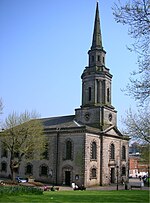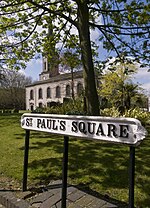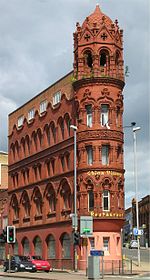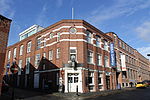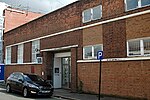St Paul's tram stop

St Paul's tram stop is a tram stop serving nearby St Paul's Square, Birmingham, England. It was opened on 31 May 1999 on West Midlands Metro Line 1. The stop is a short distance west of Birmingham Snow Hill station, which is visible from the stop. Pedestrian access is via Constitution Hill. The stop sits in the shadow of Livery Street, which, at this point, is on a blue-brick lined embankment, preventing direct access to the square. Livery Street then crosses the tram and railway lines, at a very acute angle, at the Wolverhampton end of the stop. The Birmingham to Worcester railway line runs alongside, but the stop is served only by trams, as there are no railway platforms.
Excerpt from the Wikipedia article St Paul's tram stop (License: CC BY-SA 3.0, Authors, Images).St Paul's tram stop
Livery Street, Birmingham Jewellery Quarter
Geographical coordinates (GPS) Address Nearby Places Show on map
Geographical coordinates (GPS)
| Latitude | Longitude |
|---|---|
| N 52.4872 ° | E -1.9047 ° |
Address
Livery Street
B3 1TE Birmingham, Jewellery Quarter
England, United Kingdom
Open on Google Maps
